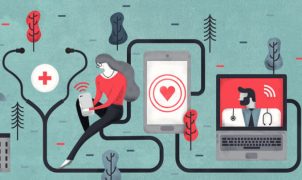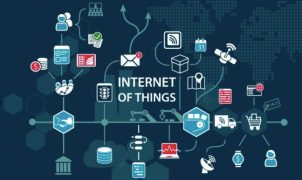The healthcare industry is currently undergoing a robust phase of innovation, with technological advancements impacting various aspects, including security, diagnostic capabilities, accessibility, and cost-effectiveness.
When discussing the positive changes that technology brings to healthcare, concepts such as blockchain, artificial intelligence (AI), and the Internet of Things (IoT) are often highlighted. Even Software as a Medical Device (SaMD) is gaining prominence. However, the foundational element supporting all these technological breakthroughs is cloud computing. This technology is a long-term trend and will continue to influence the future of healthcare.
Cloud computing has brought about significant changes in how healthcare data is created, used, stored, and shared. From traditional storage methods to the complete digitization of healthcare data, the industry has made considerable progress in enhancing data management strategies.
In this article, we delve into various aspects of the impact of cloud computing on healthcare operations and its implications for the field.

I. What is Cloud Computing in Healthcare?
Cloud computing in healthcare involves the use of remote server access over the internet to store, manage, and process health-related information. This contrasts with the traditional approach of setting up on-premises data centers for data storage. This alternative method provides stakeholders in healthcare with flexibility in accessing stored data on remote servers.
According to a BCC report, the global market for cloud computing in healthcare is expected to reach USD 35 billion by 2022, with an annual growth rate of 11.6%.
The transition to cloud technology offers dual benefits for both patients and healthcare service providers. From a business perspective, cloud virtualization has proven its value by reducing operational costs and supporting healthcare service providers in delivering top-notch personalized healthcare services.
Conversely, patients are becoming accustomed to immediate access to healthcare services. Moreover, cloud computing enhances patient interaction by granting them access to their health data, thereby improving medical examination outcomes.
The ability to access remote healthcare services, combined with real-time data sharing and synchronization, eliminates geographical barriers to healthcare service access.
II. Benefits of Cloud Computing in Healthcare
The healthcare landscape evolves daily, with technology playing a crucial role in improving patient care. Cloud computing is a recent standout technology, impacting healthcare operations. Cloud solutions offer healthcare service organizations numerous benefits, including scalability, security, compliance, rapid recovery, collaboration, cost reduction, enhanced patient experience, innovation, remote monitoring, community health management, and improved accessibility.
1. Enhanced Scalability and Flexibility:
Cloud computing allows healthcare organizations to rapidly and easily expand their IT infrastructure, avoiding the need for costly hardware and software updates. This flexibility enables better management of patient volume and expansion of services without significant capital investment.
2. Improved Data Security and Regulatory Compliance:
Cloud computing provides essential features for compliance and enhanced data security for healthcare operations. Storing data securely in external centers protects sensitive patient information from risks and data breaches. Moreover, cloud solutions support healthcare service providers in complying with strict privacy data requirements like Decree 13/2023/NĐ-CP and other legal obligations.
3. Faster Disaster Recovery:
In the event of a disaster or system failure, healthcare organizations need quick data and system recovery. Cloud computing offers healthcare service providers the ability to recover swiftly, ensuring uninterrupted patient care. Through cloud disaster recovery solutions, organizations can restore critical data and systems within minutes, significantly reducing service downtime.
4. Enhanced Collaboration and Communication:
Cloud computing aids healthcare organizations in promoting more effective collaboration and communication, both internally and with external collaborators. Cloud solutions ensure instant access to secure patient data, fostering smooth collaboration between healthcare service providers to improve service quality.
5. Cost Savings in IT:
Cloud computing provides healthcare organizations with a means to reduce IT costs by eliminating the need for expensive hardware and software updates. Through cloud solutions, healthcare service providers only pay for the necessary computing resources, avoiding substantial capital investments.
6. Improved Patient Satisfaction:
Cloud computing enhances patient satisfaction by granting healthcare service providers immediate access to patient data and critical information. With information on the patient’s health status, healthcare providers can make informed decisions about treatment, ultimately delivering better and more suitable healthcare services.
7. Greater Flexibility and Innovation:
Cloud computing enables healthcare organizations to have better flexibility and innovation with access to advanced technologies and software applications. By implementing cloud solutions, healthcare service providers can quickly and easily test new technologies and software applications, skipping the need for significant capital expenditure. This fosters innovation in the industry, leading to improved patient care services.
8. Remote Patient Monitoring:
Cloud computing has the capability to enhance remote patient monitoring, allowing healthcare service providers to deliver better services to patients in their homes. Through cloud solutions, healthcare providers can access real-time health data and crucial information, enabling them to monitor patients more effectively and address potential issues promptly.
9. Strengthened Population Health Management:
Cloud computing aids in strengthening population health management for healthcare organizations through immediate access to patient data and critical information. With information about the patient’s health status, healthcare service providers can identify underlying health issues and proactively intervene, ultimately improving patient outcomes and limiting healthcare costs.
10. Improved Accessibility:
Cloud computing helps healthcare organizations enhance their ability to access critical patient data and necessary information. Through cloud solutions, healthcare service providers can retrieve patient data and relevant information from anywhere and anytime, as long as there is an internet connection. This capability enables healthcare service providers to access patient data and essential information while on the move, allowing them to provide better healthcare services and make accurate decisions regarding patient health.
III- Frequently Asked Questions about Cloud Computing in Healthcare
1. How is cloud computing integrated into the healthcare system?
Cloud computing provides healthcare organizations with a secure infrastructure that enhances the scalability and flexibility of data management systems. The core functions serving as the foundation for cloud services in healthcare include permission granting, authentication, data storage, data security, and data integrity. The following steps outline the operational mechanism of cloud computing in healthcare:
- Patients request permission from the public cloud server, which is then forwarded to the private cloud server.
- Permission requests are verified and accepted or rejected.
- Doctors request access permission to patient data.
- Once approved, doctors access the data stored in the cloud.
- Doctors provide patients with medical guidance using the accessed data.
2. What are the leading applications of cloud computing in healthcare?
Here are some key applications of cloud computing in healthcare, contributing to the development of a technology-driven healthcare ecosystem:
- Remote medication and telehealth services.
- Information management systems.
- Digital libraries.
- Clinical Decision Support Systems (CDSS).
- Remote medical education at universities.
- Enhanced practice management.
- Population health management.
- Bioinformatics software.
- Physical education programs.
These applications leverage cloud computing to create a comprehensive healthcare technology infrastructure.
3. What are the security challenges of cloud computing in the healthcare sector?
Primary security challenges of cloud computing in healthcare include access control, identity management, network security, authentication, internet-based access, authorization, and vulnerabilities to cyberattacks. These pose significant concerns about data security and privacy.VNG Cloud adheres to international information security standards such as ISO 27017. Moreover, products like vServer and vStorage integrate IAM – Identity and Access Management solutions across all VNG Cloud resources and services, allowing the establishment of security rules for managing resources based on user, enterprise, and different roles.
4. What are the barriers to integrating cloud computing into the healthcare industry?
Despite the numerous advantages, there are some barriers to the adoption of cloud computing in the healthcare industry. These barriers include concerns related to data security, privacy issues, lack of interoperability standards, resistance to change, and the initial costs associated with transitioning from traditional systems to cloud-based solutions.Healthcare service providers need to address these concerns through robust security measures, compliance with privacy regulations, and effective change management strategies to facilitate a smooth transition to cloud computing.
IV- Case Studies: Success Stories of Cloud Computing in Healthcare
1. University Medical Center Leverages Cloud for Patient Care Enhancement:
University Medical Center (UMC) adopted cloud computing to improve patient care and enhance medical services. By migrating to cloud-based systems, UMC streamlined its data management processes, resulting in faster access to patient records, improved collaboration among healthcare professionals, and more efficient resource allocation.The cloud infrastructure allowed UMC to implement innovative healthcare solutions, such as telemedicine and remote patient monitoring. This, in turn, led to increased patient satisfaction and improved healthcare outcomes.
2. Cloud-Based EHR System Transforms Healthcare Delivery:
A healthcare provider embraced a cloud-based Electronic Health Record (EHR) system to revolutionize its healthcare delivery model. The cloud-based EHR system facilitated real-time access to patient data, enabling healthcare providers to make informed decisions promptly.This transition resulted in enhanced patient safety, reduced medical errors, and improved overall efficiency in healthcare service delivery. The cloud-based EHR system also played a pivotal role in ensuring regulatory compliance and data security.
3. Remote Monitoring and Cloud Computing in Chronic Disease Management:
A healthcare organization implemented cloud computing for remote monitoring in chronic disease management. By leveraging cloud solutions, the organization enabled patients with chronic illnesses to monitor their health parameters at home.The cloud platform aggregated real-time data from various monitoring devices, providing healthcare professionals with a comprehensive view of patients’ health statuses. This proactive approach allowed timely interventions, reduced hospital readmissions, and improved the overall quality of care for patients with chronic diseases.
V. Future Outlook: The Continued Role of Cloud Computing in Healthcare
Cloud computing is positioned to play an even more pivotal role in shaping the future of healthcare. With ongoing technological advancements and the integration of emerging technologies like AI, blockchain, and edge computing, the healthcare industry is poised for transformative changes.
- Integration with Emerging Technologies: Cloud computing will increasingly integrate with emerging technologies such as AI, machine learning, and blockchain to enhance data analytics, security, and interoperability. This integration will pave the way for more personalized and effective healthcare solutions.
- Edge Computing in Healthcare: The combination of cloud computing and edge computing will become more prevalent in healthcare. Edge computing involves processing data closer to the source (e.g., medical devices), reducing latency and improving real-time decision-making. This will be particularly valuable in applications like remote patient monitoring and telehealth.
- Blockchain for Enhanced Security: Blockchain technology will be further incorporated into cloud-based healthcare systems to bolster security and transparency. Blockchain’s decentralized and tamper-resistant nature can enhance data integrity, authentication, and secure sharing of healthcare information.
- Advanced Telehealth Services: Cloud computing will continue to be a cornerstone in advancing telehealth services. The ability to securely store and transmit health data in real-time will contribute to the expansion of remote consultations, monitoring, and diagnostics.
- Data Interoperability and Standardization:The healthcare industry will strive towards improved data interoperability and standardization, facilitated by cloud computing. Efforts to establish common data exchange formats and standards will enhance the seamless sharing of patient information across different healthcare systems.
- Cybersecurity and Privacy Measures: As cloud-based healthcare systems expand, there will be a heightened focus on cybersecurity and privacy measures. Innovations in encryption, access controls, and identity management will be crucial to safeguarding patient data and maintaining trust in cloud-based healthcare solutions.
- Regulatory Compliance and Governance: Cloud service providers catering to the healthcare industry will continue to prioritize regulatory compliance and governance. Adherence to international standards and healthcare regulations will be essential to building and maintaining trust among healthcare organizations and patients.
Conclusion: Embracing the Cloud for a Healthier Future
Cloud computing has emerged as a transformative force in the healthcare sector, offering a myriad of benefits ranging from improved scalability and flexibility to enhanced data security and patient satisfaction. As the industry continues to navigate the complexities of a rapidly evolving technological landscape, cloud computing will remain a cornerstone for innovation and progress.
The successful integration of cloud-based solutions into healthcare operations requires a strategic and holistic approach. Healthcare organizations must prioritize data security, privacy, and compliance while harnessing the power of cloud computing to drive advancements in patient care, research, and overall healthcare delivery.
In the coming years, the synergy between cloud computing and emerging technologies will further redefine healthcare paradigms, ushering in an era of personalized, accessible, and technologically advanced healthcare solutions. As stakeholders in the healthcare ecosystem embrace the cloud, the vision of a healthier future, supported by cutting-edge technology, becomes increasingly attainable.
Cre: vngcloud























































































































































